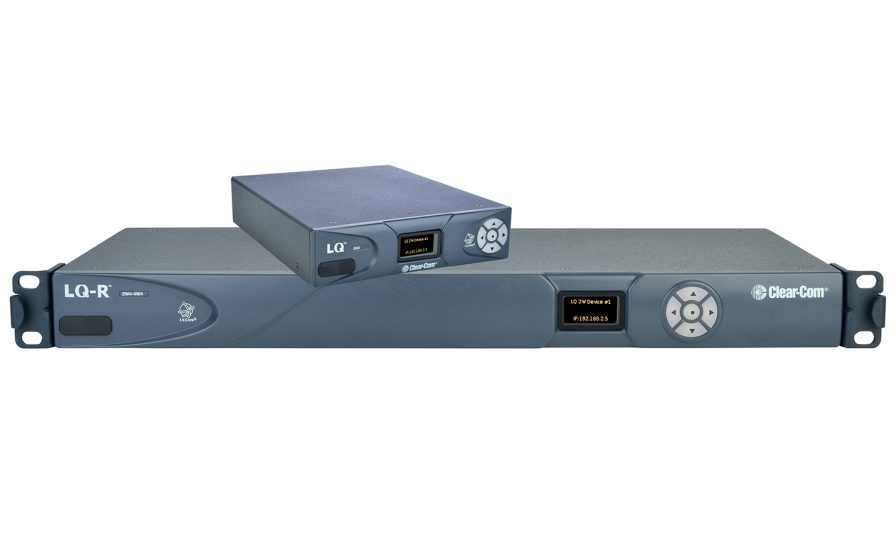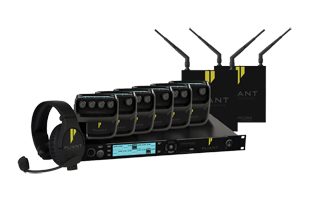Tech Focus: Intercoms, Part 1 — Wireless, IP Are the Next Evolution
In a rapid migration, each offers its own benefits and restrictions
Story Highlights
The audio industry’s transition to digital from analog took a decade spanning the 1980s and ’90s; the broadcast business spread it out over a shorter but still lengthy period in the aughts. The next great migration is from conventional wired signal transport to both wireless and AV over IP, and it’s compressing the tectonic shift of the earlier transitions into an even shorter time frame. No category illustrates all this better than what’s going on in intercoms now.
“No doubt wireless intercoms will continue to be a major focus this year, after the changes in the UHF range, but the interesting stuff is coming out of SMPTE 2110,” says Clear-Com Marketing Outreach Manager Vinnie Macri, referring to the newly released (and still evolving) suite of standards around media over IP. He adds that, although intercom manufacturers will have to develop new tactics around IP distributed antennas serving higher-frequency wireless systems, the bigger challenges — and payoffs — will come as intercoms and everything else migrate to IP networks.
“Imagine disparate intercoms in a stadium, VoIP phones in production trailers, technicians on mobile-device intercoms with producers, directors. and everyone else,” he says, “all accessible on the same network.”
Clear-Com’s LQ system was developed specifically for IP-based signal transport, Macri says, and last year added SIP IPPBX capability and a tablet/mobile application connecting traditional intercoms with Agent-IC mobile users.
LQ is already being deployed in that way. He cites a New Year’s Eve live network broadcast that used it for intercoms onsite. The benefit, he says, is ubiquitous real-time connectivity anywhere a LAN or WAN extends to. That’s particularly useful for college sports, which are already connecting to larger broadcast networks over IP. The challenges, Macri acknowledges, will be managing all of that connectedness.
RF Disruption Created Opportunity
According to Pliant Technologies President Gary Rosen, wireless has rapidly become the norm for many intercom applications, driven by more-complex and large-scaled events, including sports. Pliant’s range of systems, such as its CrewCom platform, are used to cover intra-venue communications for such events; technology from sibling Coachcomm uses Pliant’s proprietary X Cart platform and covers direct coaching applications. “As a result,” he says, “the demand for wireless communications in general is up dramatically.”
Rosen agrees that IP-based communications are also on the rise but points out that there are limits: IP works best in heavily controlled environments, such as studios and plants, where the internal LAN is most robust. Extending IP-based comms to individual smartphones is possible but, he cautions, has significant restrictions, such as added latency and degraded performance in loud environments.
Instead, he sees more flexibility for wireless in the 2.4 GHz and 900 MHz ranges, combined with Pliant’s conference-type networking system, which uses neither conventional matrixes nor partylines. “The 2.4 GHz [range] can be engineered to be very robust and most environments,” he explains. “Unlike with analog RF, you can actually share spectrum well even with a good amount of other wireless 2.4 GHz signals active in the area.”
The Allure of AoIP
The intercom business, though, is very interested in AoIP. “Take cabling efficiency as an example,” suggests Martin Dyster, VP, business development,TV Solutions Group, Telos Alliance. “Instead of dealing with multiple-line audio or mic cables, you’re working in most cases with a single piece of Cat 6, fiber, and an Ethernet switch connection. It doesn’t get much simpler than that. IP also allows production to be managed anywhere, not just onsite in a traditional OB truck. Multichannel audio, 4K video, and communication audio can be backhauled from the venue to the broadcaster’s HQ from nearly anywhere in the world. A system such as our Telos Infinity IP Intercom is especially suitable, as it supports SIP connectivity.”
Dyster believes that RF will remain a critical platform for communications into the future, although the environment won’t be as welcoming as it used to be: “Event production and broadcast companies are definitely feeling the effect of the loss of key parts of the UHF spectrum. Many manufacturers have been quick to make the move to DECT-based wireless products operating in license-free 1.9 GHz and 2.4 GHz frequency bands. Forced changes create their own challenges, but smaller companies and mainstream brands have met the challenge head-on and offer some very clever solutions to help broadcasters navigate the changing landscape.”
He is cautious about the integration of personal mobile devices into such networks but notes that, with proper management, they can significantly expand a system’s potential.
“If you’re using a mobile handset as a part of your intercom system, you’re not going to be using it to place or receive a cellular call at the same time, for example,” he explains. “[But] they’re powerful tools and are becoming an increasingly important part of a remote kit. With commercially available softphone applications like Luci Live and Bria, a mobile phone can connect to a SIP server and serve as an ad hoc connection point to an intercom system.
“Some programs,” he continues, “are quite advanced and provide an entire intercom panel as part of the GUI, making them useful for IFB or as a backup communications trunk between, say, an OB truck and production control. Users want the flexibility of being able to connect with someone in another part of the world just as easily as someone standing in the next room but with the ease that you connect using your mobile phone and with the same audio quality that IP can provide.”
Riedel Product Manager Karsten Konrad sees both wireless and IP making deeper inroads into the category. “In the past, no single wireless system has been able to provide reliable coverage in harsh sports-broadcasting environments,” he says, adding that “a new era of wireless products are fully integrated into modern intercom systems and deliver outstanding performance even in the most difficult environments, such as sports stadiums.”
IP’s main advantages, Konrad adds, are flexibility and the ability to put a complex matrix on a single cable. However, he warns that extending that to personal mobile devices could endanger reliability. “Reliability is still the most important concern for intercom systems. Using common mobile devices comes with risks,” including battery fatigue and apps that can force a device to reboot.
On the other hand, he acknowledges that recent RF disruptions have made the sector somewhat challenging. But, he adds, “wireless intercom users who now need to replace their systems can look at [RF] reallocation as an opportunity to get new systems that take advantage of more-stable frequencies, such as the DECT bands, as well as reap the benefits of the technological improvements that new systems provide. Today’s offerings can feature NFC communications for beltpack registration, modern codecs for improved audio and RF performance, and greater range.”
Intercoms likely have a lot of evolutionary headroom left. RF disruption unsettled the wireless waters for this category as it did for microphones, but, similarly, it has also pushed open doors to alternate frequencies that have their own advantages. At the same time, the momentum behind migration to IP-based distribution is strong, as it is for other aspects of broadcast audio. As with much in audio, change is the one constant.
For Tech Focus: Intercoms, Part 2 — What’s Currently on the Market, CLICK HERE.


